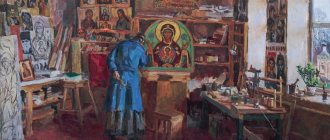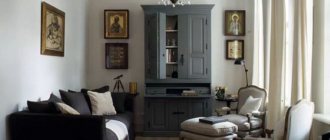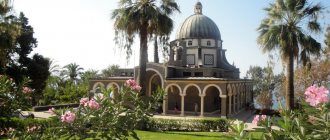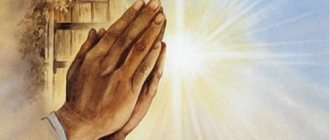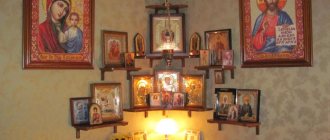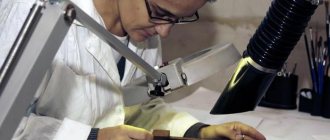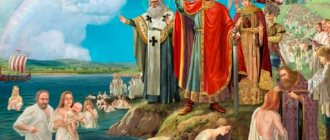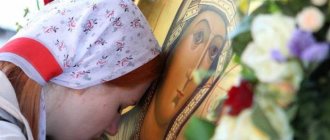What is an icon
An icon is a graphic image that embodies the face of a celestial being or a sacred event. But not all paintings painted on sacred subjects are considered icons. All sacred graphic works are divided into the following groups:
- paintings on religious themes;
- folk icons;
- church icons.
Icon-making in Rus' was considered a gift from God and a spiritual feat
The Official Church considers an icon to be an image painted in accordance with canonical and iconographic rules. It should also be remembered that an icon is not an idol or a talisman, but a part of the Divine Liturgy, which is a conductor of the prayerful appeal and faith of an Orthodox Christian.
Cutting clothes to perfection
Approximately in the 16th century, the registration of clothes “under the feather” with created gold began to appear on icons. Such elements indicate the divine origin of the clothes. Registration "under the pen" is carried out in three stages. At the beginning, with a wide brush, general folds are drawn in stripes in areas of highlighting. Next, using a smaller brush, they are divided into “subfolds”. Finally, with a very thin brush, a marking is applied along the edges of the “subfolds,” which gives the folds a rigid contour. Additionally, the necessary accents are placed at the end. To give the folds the desired shine, the created gold is carefully polished with a “tooth”.
Story
The first icons appeared back in the time of the apostles. The ancestor of icon painting is called the Evangelist Luke. It has received the greatest development in countries professing Orthodoxy. The main centers of icon painting include the following countries:
- Byzantine Empire;
- Kievan Rus and Muscovy;
- Bulgarian kingdom.
In the history of icon painting, there are several main stages, which are characterized by unique distinctive features in the manner of execution, composition and drawing of images.
Lettering and strokes
These elements “assemble” the icon into a single composition. They complement and decorate the image, acting as its mandatory element. Previously, the inscription on the icon was carried out by the Banner (the best master). It also marked the icon. The inscription of the name of a saint can be compared to the naming of a baby. Previously, it was performed by the bishop. Today, this action has been replaced by the rite of illuminating the icon. Only after this the completed work turns into an icon. Now the Saint is looking at us from it, to whom we can and even need to pray.
Who can paint holy images
During the heyday of church religious painting, the requirements for icon painters were clearly formed. They were voiced at the Local Council of the Orthodox Church in 1551.
- A true icon painter has a meek, humble and reverent disposition.
- He should not use foul language or indulge in idle reasoning.
- The soul, thoughts and body of the person painting holy images must be pure.
- While working, you must observe fasting and abstinence, accompanying all your actions with prayer.
- The artist must closely follow the models of the ancient masters, without succumbing to the temptation of pride to surpass them.
Receiving the blessing of a confessor to paint icons is a mandatory requirement for an icon painter
Thus, an icon painter in the Middle Ages had to have a high level of personal and spiritual qualities, lead a righteous and ascetic lifestyle in order to convey the holiness of the sacred image. Most often, monks became icon painters.
In the conditions of a reviving spiritual culture, formed under the influence of modern realities, ancient requirements for icon painters are not always met. Most often, in special departments of art universities, ordinary lay people, exposed to the vanity and temptations of the modern world, gain knowledge and skills in icon painting.
You should know that the main requirement for a modern icon painter is a high level of spiritual culture and actual participation in church life. Any person who decides to create an icon must receive the blessing of a confessor, accompanied by a special prayer.
Read about revered icons:
- Icon of Christ Pantocrator
- Icon of the Holy Trinity
- Icon of the Transfiguration of the Lord
Reveal
“Reveal” the icon – this is what icon painters say when they fill in a pre-prepared drawing with paints. Please note that this stage of work is typical for traditional icon painting; you will not find it in academic painting. Pure local colors are used in icon painting. Moreover, each of them carries its own semantic load, which reveals the essence of the subject. To get the right color, most often it is necessary to combine several paints. It is quite difficult to “arrange” local colors so as to create a harmonious coloring of the icon. The basic principle of their application is that each new color should be in harmony with those that have already been applied to the icon.
How to paint an icon
Creating a holy image is hard and painstaking work, requiring a lot of spiritual and physical strength from the master. The traditions of creating icons have remained unchanged for many centuries. The whole process consists of several stages.
Wood blank
Traditional Orthodox icon is written on a board. The type of wood used depends on the area in which the craftsman works. The most commonly used trees are:
- Linden;
- larch;
- spruce;
- pine;
- cypress.
The choice of wood for making icons was determined by local traditions
An important role in the longevity of an icon painting is played by wood processing, which had the following requirements:
- It must be completely dried and seasoned.
- The board is made from a strong central part of the trunk.
- The components of large icons are held together with natural wood glue and additionally secured with dowels.
As a rule, a small recess is made on the front side of the icon, limited by narrow margins. For the convenience of further preparation, the working part is made into relief using a serrated plane or a breadboard knife.
Preparing the base
The wooden blank is covered with a special base primer called gesso. It is made from gelatin (fish glue) and chalk. The heated mixture is applied to a wooden blank and covered with pavolovo - a thin cotton cloth. After the pavolok has dried, another 10-14 layers of gesso are applied to the workpiece, each of them thoroughly drying for 24 hours.
The prepared base is sanded, giving it maximum smoothness.
Read about icons of saints:
- Icon of Saint Mary Magdalene
- Icon of the 40 Martyrs of Sebaste
- Icon of St. Gregory the Theologian
Creating an image
In the old days, several masters worked to create one icon, each of whom performed a specific process:
- The sign-maker created the outline of the image, applying the canonical examples of the chosen image to the base of the copybook. The initial work was carried out with birch charcoal, and then the outline was additionally drawn with black paint. Sometimes the outline is scratched so that the image can be seen even under a layer of thick paints.
- After working out the outline, the gilders began work, applying a thin layer of gold leaf to all the necessary details of the image.
The process of gilding an icon requires great care and precision from the master. - The dolichniki were engaged in drawing the background, clothes, small details and inscriptions.
- The work on the image of the larva was completed by masters who painted faces and hands. They also applied spaces that enliven the image, giving it brightness and expressiveness.
- Work on the icon was completed by applying a layer of drying oil - oil varnish. Dryers were engaged in this work.
Today, as a rule, all these processes are carried out by one master.
The history of icon painting began in apostolic times. Evangelist Luke is considered one of the first icon painters to this day. The origin of the most ancient icons is connected with his name. Over the many centuries of the existence of icon painting, special rules have developed, canons for painting icons, as well as various execution techniques used by master icon painters to this day.
First of all, it is worth noting that icons are divided not only by technique, but also by class. Among the main ones are images of the Holy Trinity, icons of the Mother of God, icons of Christ and passionate icons (they depict the suffering of Christ), icons of saints and icons with scenes of Orthodox holidays, as well as allegorical icons.
In terms of volume, there are waist icons (the character is depicted from the waist up), life-size (full-length), chest icons (the image of the character is depicted up to the chest), as well as main icons (the image of only the character’s head). The fragmentary type is not typical for classical icon painting. Icons are also divided according to the style of execution (different schools).
The main thing that distinguishes icons in a technical sense is their execution. Among the main techniques for creating icons, it is worth highlighting six types. The first is picturesque. Icons are painted using paints and varnish on wood or other surfaces. The material can be tempera or oil paint. Mosaic icons can also be classified as this type.
The second type is icons, embroidered or assembled from beads. As in the first case, icons in this technique are made by hand and require special care and perseverance from the artist. The third type is cast icons. Mostly such icons are made of copper using auxiliary materials using artistic casting. Often cast icons are decorated with fine artistic work. Icons-engravings can be attributed to this type. A striking example is the icons made by masters from the Ural Zlatoust.
The fourth type is carved icons. Such works are created exclusively by hand. The image is carved on wood. Metal, paint, decorative and natural stones can be used as auxiliary materials.
Type five – printed icons. In this case we are talking not about manual, but about machine work. The image is reproduced using a special printing press. Such icons are much cheaper than handmade icons. Another type is altar icons. This is a folded version of the icon, consisting of several parts. Each piece is covered with an artistic image.
A large collection of icons made in different artistic techniques is presented in the collection of religious gifts of the Great Rus' store. The gallery of the Russian House of Gifts contains hundreds of various icons made by talented Russian craftsmen. Each icon is a bright work of art, worthy of complementing the decor of a believer’s home.
Coating the icon with varnish for protection
The protective coating of the icon is the most difficult aspect. In ancient times, the icon was covered with special linseed oil. This method continues to be used today. Drying oil should be transparent and light. Its “rising” time is approximately 8 hours, and until it completely dries – a day. It is noteworthy that in the Palekh workshops there was a special room for covering paintings with drying oil. It was completely isolated from access by strangers. This prevented unnecessary movement of dust in the air.
The process of preparing to paint an icon is described in the article: Icon Painting Technology. Preparatory stages
Our workshop “Abramtsevo” produces: Iconostases for churches / Baroque iconostases / Bassmen iconostases / Tyablo iconostases / Marble iconostases / Straight iconostases
Board
The basis for the icon must be strong and durable; it personifies the inviolable laws of Existence. Like the stone tablets on which God commanded Moses to record God’s commandments to the people. We use linden boards made from well-seasoned wood with oak dowels, which prevent the board from bending.
Paints
Next, with God's help, armed with fasting and prayer, the icon painter begins the writing stage. Under the artist’s brush, the surface of the board begins to awaken and in the golden radiance of the icon, as if in the sea of Divine Grace, biblical scenes float, images of the Savior, the Mother of God, and saints appear.
What colors should you use to paint an icon? The answer is not difficult to give. The colors express the clearly contemplated essence of things, the spiritual essence of the icon. The choice of colors is not made by the artist, but by the mind of history.
Tempera (PVA) with egg emulsion
For example, modern PVA tempera (artificial pigments on a synthetic basis) with the addition of egg emulsion can achieve good results. Modern cadmiums, cobalts and various oxides are light-resistant, strong and durable, the colors on the icon look bright and rich. They have many advantages, especially with skillful handling and rich experience. Situations often arise when the use of PVA tempera is logical and justified.
Natural mineral pigments
But still, we prefer to paint with the same paints that many generations of icon painters painted before us, with natural pigments. Minerals, semi-precious stones, ocher, earths manually ground with a chime and mixed with yolk.
Nothing can imitate the noble color of natural cinnabar, the purity and depth of lapis lazuli, the delicate green-blue color of dioptase, the solemn golden shine of orpiment and realgar. In addition to their unique and natural color, they convey remarkable optical effects due to the transparent crystalline structure of minerals that actively reflect light. We specifically add quartz to some ocher.
By manipulating the fineness of grinding, it is possible to obtain a color tone of different saturation from the same mineral. Natural pigments produce more transparent and delicate melts. These colors do not fade over the centuries, delighting us with the natural beauty and diversity of the natural palette. It is very difficult to make a high-quality copy of an ancient icon without using the same materials and writing techniques that were used to create the original.
